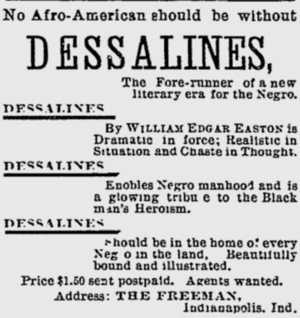William Edgar Easton facts for kids
Quick facts for kids
William Edgar Easton
|
|
|---|---|

Easton c. 1915
|
|
| Born | March 19, 1861 New York City, New York |
| Died | January 10, 1936 (aged 74) Los Angeles, California |
| Notable works | Dessalines (1893) Christophe (1911) |
| Spouse |
Mary Elizabeth Easton
(m. 1888) |
William Edgar Easton (born March 19, 1861 – died January 10, 1936) was an American writer, reporter, and activist. He wrote two important plays about the Haitian Revolution. These plays were Dessalines (1893) and Christophe (1911). Both plays told stories about key leaders from Haiti's fight for freedom.
Contents
William Easton's Life Story
His Early Life and Education (1861–1883)
William Edgar Easton was born in New York City on March 19, 1861. His mother, Marie Antoinette Leggett-Easton, spoke French. Her family came from France and had lived in New Orleans. His mother's family also had a connection to the Haitian Revolution. His father was Charles F. Easton.
William grew up mostly in New Bedford, Massachusetts. When he was 13, his mother passed away. After this, his godmother, known as the "Baroness de Hoffman," took care of him. She then placed him with a Catholic priest.
Easton went to several Catholic schools. These included a seminary in Trois-Rivières, Quebec, and La Salle Academy in Providence, Rhode Island. He also attended a college run by the Congregation of St. Croix, possibly Collège Saint-Césaire in Saint-Césaire, Quebec.
Moving to Texas (1883–1901)
At age 22, Easton moved to Texas. This was a big and unusual step for someone who had just finished seminary school in Canada.
He married Mary Elizabeth Easton in 1888 in Austin. For a few years, from about 1882 to 1885, he worked as a teacher.
While in Texas, Easton became a newspaper editor. He edited papers like the Citizen, the Blade, and the Globe. He also became the first president of the Colored State Press Association. Easton also held several roles in the state's Republican Party, starting his long career as an activist.
Life in California (1901–1936)
Easton moved to California around 1901. In 1924, he wrote that he had lived in California for 23 years. At that time, he lived in Los Angeles and had three daughters and one son.
In California, he continued his work in journalism and politics. He worked as a speechwriter for the Republican and Progressive parties.
In 1911, he wrote an article in the Los Angeles Herald. In it, he strongly spoke out against an attack on Booker T. Washington. Easton wrote that harming Dr. Washington would be a huge loss for his community and a danger to the whole nation.
During World War I, Easton was chosen by Emmett Jay Scott to work for the Department of War. After the war, he helped gather information about the contributions of African Americans in California during the war.
William Edgar Easton passed away on January 10, 1936, at his home in Los Angeles. He was buried at Calvary Cemetery.
His Religious Beliefs
Easton was Catholic until after 1893. Then, he joined the African Methodist Episcopal Church. Before this change, he was active in the Colored Catholic Congress. This group was started in the late 1880s by Daniel Rudd.
In 1893, he gave a speech in New Orleans called "The Catholic Church and the Negro Race."
William Easton's Plays

Easton wrote two plays that became well-known. Both were about important figures from the Haitian Revolution. These plays were Dessalines (1893) and Christophe (1911). Henrietta Vinton Davis was a famous actress who produced and starred in both plays. Easton also wrote two shorter plays, but they were not performed.
About the Play Dessalines
Dessalines is described as a "romantic drama" written in a poetic style. The main character is Jean-Jacques Dessalines, a key leader in Haiti's early history. The play focuses on Dessalines's adventures and his relationship with a character named Clarisse.
Some experts believe Dessalines showed a different view of Black men in the late 1800s. At that time, many people had unfair ideas about Black people. Haiti's independence, achieved by leaders like Dessalines, proved that Black people could govern themselves.
In his introduction to Dessalines, Easton wrote about the importance of remembering Black heroes. He felt that Black people should tell their own stories. He hoped his play would help start a new era of plays written for Black actors.
The play Dessalines first opened in Chicago in September 1893. It was performed at Freiburg's Opera House. The cast was made up entirely of Black actors, with Henrietta Vinton Davis playing Clarisse.
The premiere happened at the same time as the 1893 World's Columbian Exposition. However, it was not part of the official Exhibition. Instead, it was staged as a protest. It showed disagreement with how the Exhibition excluded African Americans. The play was also performed in Pittsburgh in 1909 and Boston in 1930.
A newspaper called the Indianapolis Freeman reviewed the play in April 1893. The reviewer wished Easton had chosen a topic from American history. Later, the Freeman offered copies of Dessalines to its readers as a holiday gift.
A writer named Albion W. Tourgée reportedly said that Dessalines was a very high example of writing by an African American.
About the Play Christophe
The play Christophe was reportedly written for Henrietta Vinton Davis. It was performed in New York and Los Angeles in the spring of 1912. In New York, it opened at the Lenox Casino in Harlem.
Besides Davis, other actors in the play included R. Henri Strange and Lawrence Chenault.
The money earned from the New York performances went to a Black regiment of the New York National Guard.


